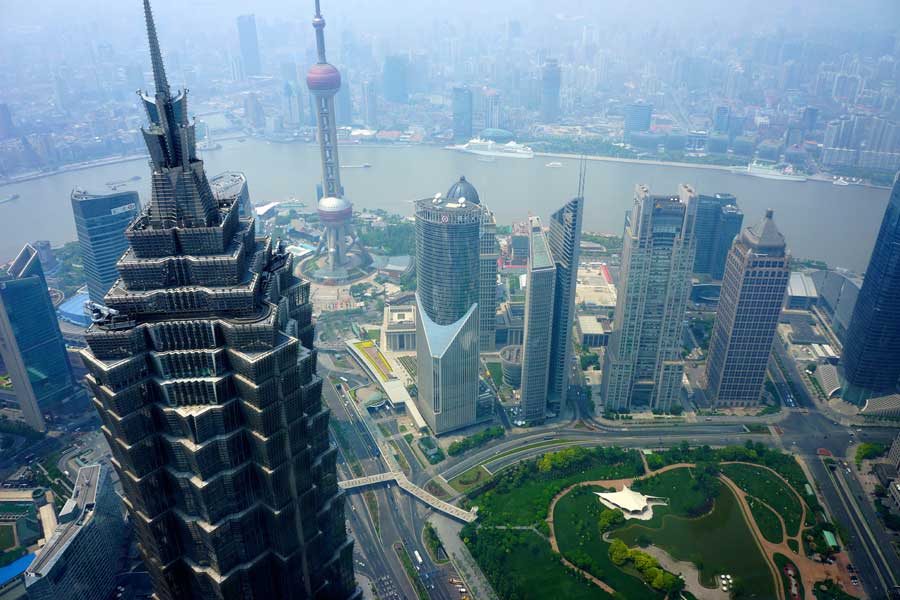By Everett Potter
When I first visited Shanghai in 1984, it was a cramped, backward-looking place still awakening from its long slumber under the reign of Chairman Mao. The hotels were musty, having for decades served mostly visiting Communist bureaucrats and diplomats. The Shanghai Museum of Art had dusty exhibit cases of antiquities, somnolent guards and few visitors. The streets were thronged with bicycles and the occasional VIP in a red-flagged limo. The old “concessions”—neighborhoods once administered by foreign powers—had been reduced to warrens of shambolic mansions in which dozens of families dwelt with clotheslines running out of windows. Memorably, I saw a jazz band of elderly Chinese gentlemen who played nightly at the venerable Peace Hotel along the Bund, a thoroughfare fronting the river. The bar had hosted the likes of Charlie Chaplin and Noël Coward in the 1930s, and you could feel it.
Was it the same city when I went back just last year? Yes and no. Shanghai is still a fascinating patchwork of China’s history, with many visible remnants of its imperial past and its expansion by the British more than 170 years ago as a base for selling opium to the natives. But today it styles itself “the City of the Future.” As the only city to claim two of the world’s 10 tallest structures, it’s a metropolis of futuristic towers filled with newly minted multimillionaires and conspicuous consumption of every brand name from Hermès to Ferrari. And the eight-minute ride on the magnetic-levitation train from the airport reaches 267 mph and makes you feel you’re rushing headlong into times unknown.
The best place to bask in Shanghai’s 21stcentury excess is the Pudong financial district, with as many skyscrapers as 20 Manhattans and a neon display that for sheer exuberance outshines Times Square. Structures such as the 1,380-foot Jin Mao Tower (finished in 1999) and the Shanghai World Financial Center (1,614 feet, 2008) were superseded last year by the 2,073-foot Shanghai Tower, the world’s second-tallest building. The symbol of this mega-city, the 1,535-foot Oriental Pearl TV Tower, seems to be made from giant Tinkertoys.
But the architectural Shanghai isn’t all vertical. As the nation’s longtime commercial hub, this port city in the Yangtze river delta has buildings that reflect a rich, eclectic history— they range from centuries-old classic Chinese pagodas to imposing homes that could have been dropped in from Paris.
The good news for traditionalists like me is that the Old City still offers a veritable maze of lanes that are well worth exploring on foot, with small markets and glimpses of street life. So does nearby Yuanmingyuan Road, which has some well-preserved turn-of-the-last-century buildings. During a building boom in the 1920s and ’30s, Shanghai was China’s window on the West, and its architecture reflects that fact. There are ornate Western-style mansions and multistory structures with pagoda-like roofs.
Want to go further back? The Square Pagoda was built in the Song Dynasty, about 1,000 years ago. This grand cultural relic looks like a wedding cake; it’s surrounded by ancient buildings and gardens. The former French Concession is also home to Fuxing Park, where old men follow a Far East custom, bringing pet birds in bamboo cages to hang on tree branches to sing while the men smoke and gossip.
What has changed most, perhaps, is the arts scene. The Shanghai Art Museum now has one of the world’s best collections of ancient bronzes, ceramics and calligraphy. The Rockbund Art Museum, a restored 1932 Art Deco building, is the place to go for strikingly fresh exhibitions. And the West Bund, becoming a world-class culture hub, includes an art center that is the site of an annual art fair, and the Yuz Museum, with contemporary works. The Long Museum West Bund was China’s largest private art museum when it debuted in 2014. DreamWorks studio is expecting to open its $2.5 billion Shanghai DreamCenter in 2017, with an animation studio and an entertainment complex.
When it comes to dining in Shanghai, be sure to drink tea in the garden at the Ming Dynasty-era Guyuan Teahouse on Fuxing Zhong Lu in the French Concession. Cha’s Restaurant, a traditional cha chaan teng (tea eatery) is owned by a Hong Kong movie producer. Din Tai Fung offers incredible soup dumplings (xiaolong bao), with a delicate skin wrapped around a juicy pork or crab filling. Jishi is small and crowded but serves classic Shanghai food, from tofu skin with mushrooms (fuzhu) to sweet-and-sour spare ribs (tangcu paigu) and crab with vermicelli sheets (xiefen fenpi). At night, head to Shouning Lu, which has street food cooked on portable grills, food carts and the aromas of roast duck and crayfish.
The rooftop Bar Rouge at Bund 18 is great for post-dinner people watching—it’s a good way to get a handle on current Shanghai residents. As for lodging, Shanghai has an ever-expanding roster of the world’s best luxury hotels, from Ritz-Carlton Shanghai, Pudong to Four Seasons Hotel Shanghai and The Peninsula Shanghai. I’m partial to the Park Hyatt Shanghai, an oasis of calm in the frenetic city. I also like Waterhouse at South Bund, a new 19-room boutique hotel in a former 1930s warehouse—and an antidote to high-rises.
But my heart belongs to the old Peace Hotel along the Bund, now the fully redone Fairmont Peace Hotel. It’s sleek and modern, but luckily the management has restored the Jazz Bar, where a combo of Chinese gentlemen age 80 and up plays jazz standards nightly. Cocktail in hand, I can almost be persuaded— once again— that I’m back in the Shanghai of the ’30s.
